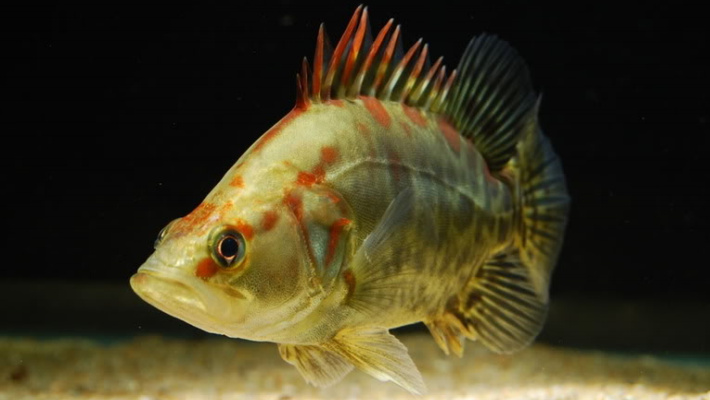|
Perch
Freshwater
percid (Percidae) fish can be divided into the two groups depending on type of
their activity and sensory equipment. European perch,
Perca fluviatilis, American yellow
perch, Perca flavescens, and numerous
American darters (Etheostoma)
demonstrate the day type of activity (first of all of the feeding activity),
are visually guided fish and, thus, may be included in the first group.
In
laboratory and natural conditions, both perches usually do not eat immobile as
well as dead food and demonstrate relatively weak responses to food odors or
their absence. According to Mirza et al. (2003), an aqueous brine shrimp (Artemia spp.) extract (5 g of frozen shrimp
in 150 ml of distilled water for 1 hour) induces searching movements in P. flavescens. Both perches, however, do
not go practically into the minnow traps baited with the animal lures (in
contrast to cyprinid, cobitid and other fish).
In
aquarium, blinded P. fluviatilis may
find the pieces of earthworms using olfactory and gustatory systems (Wunder,
1927). But convergence of perch with brown trout, Salmo trutta, on sensory system utilization is incorrect.
Skin of
percid fish contains alarm pheromone that is documented in yellow perch P. flevescens, common ruffe Gymnochephalus cernuus and other
species. Releasing in the water, this pheromone induces in small
(planktivorous) perch an avoidance behaviour, whereas large (piscivorous) perch
display feeding behaviour (Mirza et al., 2003; Harvey & Brown, 2004).
Zander
Another
group is formed by percids with the twilight or nocturnal type of feeding
activity with the morphologically developed chemosensory and lateral line
systems. Three Europen zanders or pikeperches, Stizostedion lucioperca , S. volgensis
and estuarine pikeperch S. marinus,
both North American zanders, walleye S.
vitreus and sauger S. canadensis,
all species of Gymnocephalus genus
(such as common ruffe G. cernuus,
Donets ruffe G. acerina, striped
ruffe G. schraetser and other), all
species of Zingel genus (such as Z. zingel, Z. streber, Z. balcanicus and
other) and sculpin-perch Romanichthys
valsanicola (single species of Romanichthys
genus) belong to this group. Three last genera are represented in temperate
Europe, except common ruffes which occupy mainly boreal areas around the world
being active intruders in America.
Underyearling walleyes are mainly visually guided fish with
the olfactory system that can detect individual chemicals and artificial food
odors (Rottiers & Lemm, 1985). In particular, fish are
attracted by amino acids (arginine), betaine, washings from live Daphnia and Artemia but reject many other chemicals (cysteine, glycine,
glycine-betaine).
According
to Valentinčič (2004),
walleyes and some other fish occupy an exclusive niche of visually guided
predators with the secondary role of chemosensory system in feeding behaviour.
Electrophysiological dara indicate that olfactory system of walleyes is broadly
tuned while gustatory system of them is tuned very narrowly. On the other hand,
behaviuoral data for wild walleyes show that over 90 % of fish do not use
chemical senses to release feeding excitatory state. In addition, walleyes
which are not conditioned to eat nonliving foods during their early life do not
use olfactory and taste systems to control feeding bahaviour (Valentinčič, 2004).
The olfactory
sensitivity of nocturnal percid fish to food odors, if any, is probably low. It is known, for example, that the
olfactory sensitivity of ruffe G. cernuus
to food odors (extracts of Chronomidae larvae and Tubifex sludgeworms) is about 10-2 g l-1 that
is much less than the olfactory sensitivity of cyprinid fish (Kasumyan et al.,
2003).
Attractants
Thus, there is no scientific evidence to develop feeding
attractants (that include food extracts, amino acids and other chemicals) for
perch and zander (walleye, sauger), except attractants based on pheromones and
other behaviourally significant chemicals.
Meantime,
some manufacturers offer attractants for perch and zander:
Super Juice
Walleye Scent (Blue Fox Co.) MegaStrike Fish Attractant, including unworking Pike
Formula (MegaStrike Inc.) Bombix Perche & Zander (Sensas Co.) PowerBait Attractant Walleye Formula (Pure Fishing
Inc.) Kick’n Bass Walleye Formula (Scientific Bass Products Inc.) Attractant for Walleye & Sauger (Fizards
Co.), and some more.
Some traders (like Jim Fish or Pike-Attack,
Germany)
recommend original attractants of manufacturers for perch and zander (such as MegaStrike
Lockstoff Barsch & Zander).
Feeding
attractants do not work, it is unclear whether they (such as Super Juice Walleye Scent) contain an alarm pheromone of preyfish.
Basic References
Harvey M.C., Brown G.E. 2004. Dine or dash?: Ontogenetic shift in the response of
yellow perch to conspecific alarm cues. Environmental
Biology of Fishes 70,
345-352
Kasumyan A.O., Marusov E.A., Sidorov S.S. 2003. Feeding behavior of the ruffe Gymnocephalus cernuus triggered by olfactory and
gustatory stimulants. Journal of
Ichthyology 43, S247-S254
Mirza R.S.,
Fisher S.A., Chivers D.P. 2003. Assessment of predation risk by juvenile yellow perch (Perca flavescens): responses to alarm cues from conspecifics and
prey guild members. Environmental Biology of Fishes 66, 321–327.
Rottiers D.V., Lemm C.A. 1985. Movement of
underyearling walleyes in response to odor and visual cues. The Progressive Fish-Culturist 47, 34-41
Valentinčič
T. 2004. Taste and olfactory stimuli and behavior in fishes. The senses of fish:
Adaptations for the reception of natural stimuli. 90-108
Wunder W.
1927. Sinnesphysiologische Untersuchungen über die Nahrungsaufnahme bei
verschiedenen Knochenfischarten. Zeitschrift für vergleichende
Physiologie 6, 67-98
| 







 SUBSCRIBE
SUBSCRIBE


